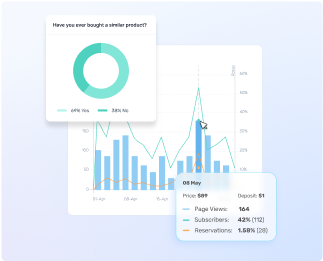In today’s fast-paced business world, guesswork is a luxury no one can afford. Enter market research: your secret weapon for making bold, informed decisions that propel your business forward. Whether you’re an ambitious entrepreneur, a savvy small business owner, or a cutting-edge marketing professional, mastering the market research process is the key to unlocking unprecedented growth and staying ahead of the competition.
Ready to transform raw data into golden opportunities? This guide will walk you through seven essential steps that turn the complex art of market research into a streamlined, powerful tool for success. From defining laser-focused objectives to leveraging cutting-edge AI analysis, you’re about to embark on a journey that will reshape how you understand your market, your customers, and your business potential.
The 7-Step Market Research Process: An Overview
Before diving into the details, let’s take a quick look at the seven steps that comprise an effective market research process:
- Define Your Research Objectives
- Develop Your Research Plan
- Collect Relevant Data
- Analyze and Interpret the Data
- Present Your Findings
- Make Informed Decisions
- Monitor and Iterate
Following this structured approach ensures that your market research is comprehensive, focused, and yields valuable insights. It’s worth noting that modern tools, such as AI-powered market research platforms like Prelaunch.com’s AI Market Research feature, can significantly streamline this process, making it more efficient and accessible for businesses of all sizes.
Now, let’s explore each step in detail.
Step 1: Define Your Research Objectives
The first and perhaps most crucial step in the market research process is defining your research objectives. This step sets the foundation for your entire research effort and ensures that you’re asking the right questions to get the information you need.
Identifying the problem or opportunity
Start by clearly articulating the business problem you’re trying to solve or the opportunity you’re looking to explore. Are you considering launching a new product? Trying to understand why sales are declining? Or perhaps you’re looking to enter a new market? Clearly defining the issue at hand will help focus your research efforts.
Setting clear, measurable goals
Once you’ve identified the problem or opportunity, set specific, measurable, achievable, relevant, and time-bound (SMART) goals for your research. For example, instead of a vague goal like “understand customer preferences,” you might set a goal to “identify the top three features that 70% of our target market considers essential in a new product within the next two months.”
Formulating research questions
Based on your goals, develop a set of research questions that will guide your data collection efforts. These questions should be specific and directly related to your objectives. For instance, if your goal is to understand customer preferences, you might ask questions like:
- What features do customers value most in similar products?
- How much are customers willing to pay for these features?
- What unmet needs exist in the current market?
By clearly defining your research objectives, you’ll ensure that your market research efforts are focused and yield the insights you need to make informed business decisions.
Step 2: Develop Your Research Plan
With your objectives clearly defined, the next step is to develop a comprehensive research plan. This plan will serve as your roadmap, outlining how you’ll gather the information needed to answer your research questions.
Choosing research methodologies
Decide whether qualitative research, quantitative research, or a combination of both will best serve your objectives:
- Qualitative research: This method explores the “why” and “how” of consumer behavior through in-depth interviews, focus groups, or observational studies. It’s excellent for gaining deep insights into customer motivations and perceptions.
- Quantitative research: This approach focuses on numerical data and statistical analysis. Surveys and polls are common quantitative methods that can provide measurable data on consumer preferences and behaviors.
Often, a mixed-method approach combining both qualitative and quantitative research can provide the most comprehensive insights.
Determining your target audience
Identify the specific group of people from whom you need to gather information. This could be based on demographics, psychographics, or behavioral characteristics. The more precisely you define your target audience, the more relevant and valuable your research findings will be.
Selecting appropriate data collection methods
Choose the most suitable methods for collecting data from your target audience. Some options include:
- Surveys (online, phone, or in-person)
- Interviews (structured or unstructured)
- Focus groups
- Observational studies
- Secondary data analysis
Consider factors such as cost, time constraints, and the type of information you need when selecting your methods. AI-powered tools like Prelaunch.com’s AI Market Research feature can be particularly helpful in this stage, offering efficient ways to gather and analyze data from various sources.
By developing a thorough research plan, you’ll ensure that your data collection efforts are efficient, targeted, and aligned with your research objectives.
Step 3: Collect Relevant Data
With your research plan in place, it’s time to gather the data that will form the basis of your insights. This step involves implementing the data collection methods you’ve chosen and ensuring that you’re gathering high-quality, relevant information.
Primary research methods
Primary research involves collecting original data directly from your target audience. This can include:
- Conducting surveys: Use online platforms, email, or in-person methods to gather quantitative data from a large sample of your target audience.
- Performing interviews: Engage in one-on-one conversations with key individuals to gain in-depth qualitative insights.
- Organizing focus groups: Bring together small groups of people to discuss your research topics in a moderated setting.
- Observational studies: Watch and record how people interact with products or services in real-world settings.
Secondary research sources
Secondary research involves analyzing existing data from various sources. This can be a cost-effective way to gather background information and supplement your primary research. Sources may include:
- Industry reports and market studies
- Government databases and publications
- Academic research papers
- Competitor websites and annual reports
- Trade association publications
Leveraging AI for efficient data collection
Modern AI-powered tools can significantly enhance your data collection efforts. These tools can:
- Automate the process of gathering and organizing secondary research data
- Analyze large datasets quickly to identify trends and patterns
- Generate survey questions based on your research objectives
- Provide real-time insights as data is collected
By leveraging both traditional methods and advanced AI tools, you can ensure that you’re collecting a comprehensive and diverse set of data to inform your market research.
Step 4: Analyze and Interpret the Data
Once you’ve collected your data, the next crucial step is to analyze and interpret it. This process involves transforming raw data into actionable insights that can guide your business decisions.
Data cleaning and preparation
Before analysis can begin, it’s essential to clean and prepare your data:
- Remove any duplicate or irrelevant entries
- Check for and correct any errors or inconsistencies
- Standardize data formats for easier analysis
- Organize data into a structure that facilitates analysis
Statistical analysis techniques
Depending on the type of data you’ve collected and your research objectives, you may employ various statistical analysis techniques:
- Descriptive statistics: Calculate means, medians, modes, and standard deviations to summarize your data.
- Inferential statistics: Use techniques like hypothesis testing and regression analysis to draw conclusions about larger populations based on your sample data.
- Correlation analysis: Identify relationships between different variables in your dataset.
- Segmentation analysis: Group your data into meaningful segments based on shared characteristics.
Identifying patterns and trends
As you analyze your data, look for patterns, trends, and insights that address your research objectives:
- Compare results across different demographic groups or market segments
- Identify common themes in qualitative data
- Look for unexpected or surprising findings that challenge your assumptions
- Consider how different data points relate to each other and what story they tell together
Remember that the goal of this step is not just to summarize data, but to derive meaningful insights that can inform your business strategy. Be open to unexpected findings and be prepared to dig deeper into areas that seem particularly relevant or intriguing.
Step 5: Present Your Findings
After analyzing your data, it’s time to communicate your findings effectively to stakeholders. The way you present your research can significantly impact how it’s received and acted upon.
Creating clear and visually appealing reports
- Organize your findings logically, starting with an executive summary of key insights
- Use charts, graphs, and infographics to visualize data and make it easier to understand
- Include relevant quotes or case studies from qualitative research to bring your data to life
- Ensure your report is well-structured with clear headings and subheadings
Tailoring presentations to different stakeholders
- Consider the specific interests and needs of your audience (e.g., executives, marketing team, product developers)
- Adjust the level of detail and technical language based on your audience’s expertise
- Focus on the findings most relevant to each stakeholder group
Highlighting key insights and actionable recommendations
- Clearly state the main takeaways from your research
- Connect your findings directly to your initial research objectives
- Provide specific, actionable recommendations based on your insights
- Include potential implications of your findings for different areas of the business
Remember, the goal is not just to share information, but to tell a compelling story with your data that motivates action and informs strategy.
Step 6: Make Informed Decisions
The true value of market research lies in its ability to inform better business decisions. This step is where you translate your research findings into strategic action.
Connecting research findings to business objectives
- Revisit your initial research objectives and evaluate how your findings address them
- Identify which insights are most critical for achieving your business goals
- Consider both the opportunities and potential risks highlighted by your research
Assessing risks and opportunities
- Use your research to evaluate the potential success of new products, services, or marketing strategies
- Identify potential obstacles or challenges that your research has uncovered
- Consider how your findings might impact different scenarios or future market conditions
Developing data-driven strategies
- Create action plans based on your research insights
- Set specific, measurable goals for implementing changes or new initiatives
- Assign responsibilities and timelines for acting on your research findings
- Ensure that all strategic decisions are directly supported by your research data
Remember that while your research should guide your decisions, it’s also important to balance data with experience, intuition, and other business considerations.
Step 7: Monitor and Iterate
The market research process doesn’t end with implementation. Continuous monitoring and iteration are crucial for long-term success.
Implementing decisions based on research
- Put your data-driven strategies into action
- Ensure that all team members understand the research findings and their role in implementing changes
Tracking results and KPIs
- Set up systems to monitor the impact of your decisions
- Track relevant key performance indicators (KPIs) that align with your research objectives
- Regularly review performance against your goals and expectations
Conducting follow-up research for continuous improvement
- Plan for periodic follow-up research to assess the effectiveness of your strategies
- Be prepared to adjust your approach based on new data and changing market conditions
- Consider implementing ongoing research methods, such as customer feedback loops or regular market surveys
By viewing market research as an ongoing process rather than a one-time event, you can ensure that your business remains agile and responsive to market changes.
Conclusion
Mastering the market research process is essential for making informed business decisions in today’s competitive landscape. By following these 7 steps – defining objectives, developing a plan, collecting data, analyzing results, presenting findings, making decisions, and monitoring outcomes – you can gain valuable insights that drive business growth and innovation.
As markets evolve and consumer preferences change, ongoing market research will be key to staying ahead. Embrace this process as a fundamental part of your business strategy, and you’ll be well-equipped to make decisions that resonate with your target audience and drive your business forward.




